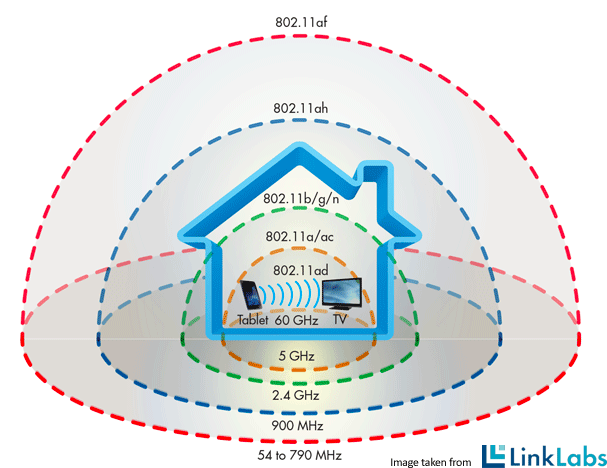Among the numerous problems with getting a network of connected "things" to talk with each other (and servers and services far away), connectivity is one of the biggest. While you can't walk down the street without being bombarded by wifi signals anymore, short-range, easily-blocked 2.4GHz wireless networking is poorly suited to the low-bandwith often geographically-dispersed nature of IoT installations. While we've come a long way from the first widely-used protocol, 802.11b, newer protocols like 802.11n and 802.11ac continue to use high-frequency signals that are easily blocked by walls, floors and ceilings and thus require lots of boosters and access points to ensure continuous coverage.
Enter 802.11ah, which I'm sure will soon be (stupidly) called "WiFi for Things." Using the same OFDM (Orthogonal, Frequency Division Multiplexing) technology that has let us cram lots of data into small slices of radio bandwidth for over a decade, 802.11ah will work inside the 900MHz frequency band commonly used for things like wireless telephones and baby monitors. Since the operating frequency is lower, 802.11ah will be able to penetrate walls and other barriers far better than it's 2.4 and 5GHz-based peers. Of course, this comes at the expense of overall bandwidth: 802.11ah is slotted to support "only" a few hundred Kbps to about 8Mbps -- more than enough for tiny sensors, but certainly not what you'll be using to beam your tablet's video to your TV. Link Labs actually has a great breakdown of how the various 802.11 standards work and what they are optimally used for, including this graphic:

While the standard was only just approved a few months ago, we've already seen some pre-production hardware that supports it, and surely more devices will come out this year and next to take advantage of its unique characteristics. 802.11ah competes with 900MHz z-wave wireless which has similar long-distance, low-bandwidth performance, but it's not an IEEE standard. In coming months we'll also start to see the production of 802.11af devices, which use the "white space" where analog TV signals used to live, to produce an even longer-distance and better-penetrating (albeit lower-bandwidth) network field. I've been petitioning the 802.11af working group to add an Easter egg that wraps the low-bandwidth communications to make them look like old episodes of "I Love Lucy" should you tune them in with an old analog TV. So far, they have not returned my calls.

 Subscribe to the M2M Insider RSS feed
Subscribe to the M2M Insider RSS feed